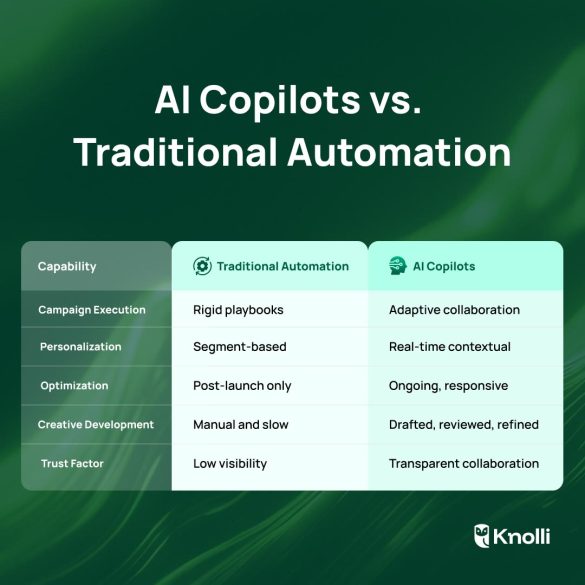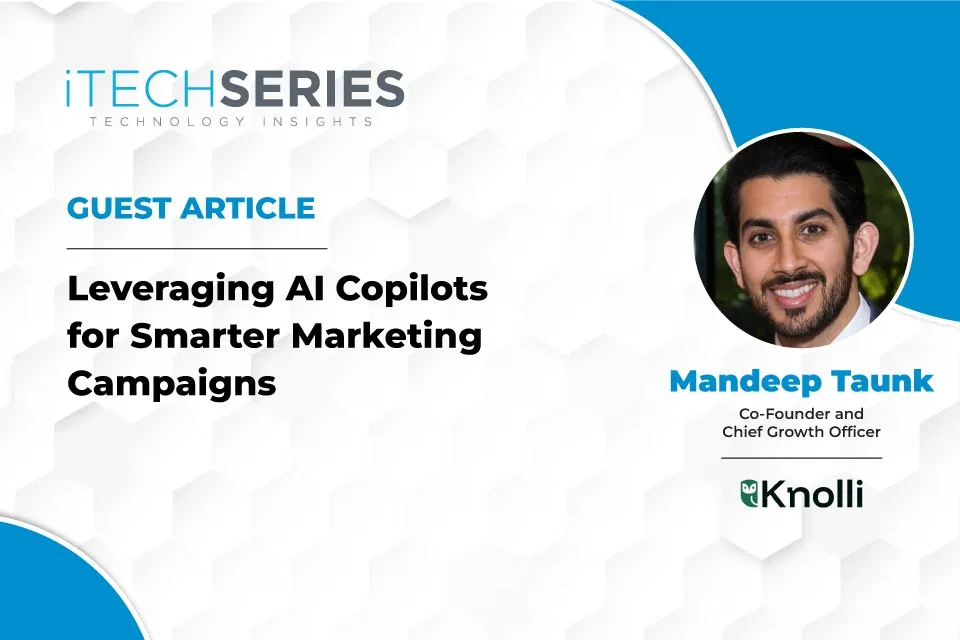Why marketers still want a say!
In 2025, there’s no shortage of tools that promise speed, automation, and hands-off execution.
But as we test these hands-free approaches (agents), a quieter desire keeps surfacing: the need to stay involved.
I wouldn’t micromanage, but I wouldn’t blindly delegate, either!
AI copilots rise to the top of the stack because they let you move faster without giving up the wheel.
They provide suggestions, flag opportunities, and draft ideas, but you will still have to make the final call. In marketing, nuance, timing, and tone matter, so that relationship is proving far more valuable than full-blown automation or using AI agents.
Why Staying Involved with AI Feels Safer?
Beneath the metrics and marketing jargon is something deeply human: We still want to know what’s going on and why. It’s hard to feel confident when AI runs in the background without any explanation.
And that confidence grows when it works with you.
That’s what I like to call the core copilot experience. That’s the difference between “run this for me” and “work through this with me.” Copilots satisfy the need for reassurance and the ability to adjust, check, and influence the outcome. So, they keep you in the cockpit even as they speed up the flight.
Why AI Copilots Work So Well for Campaigns?
Marketing campaigns live in grey areas. They require last-minute tweaks, judgment calls, context shifts, and feedback loops. And copilots are built for exactly that.
They bring:
- Structure without rigidity, so the campaigns don’t stall at the planning stage.
- They provide real-time feedback so that marketers can make decisions quickly.
- Creative collaboration means marketers spend more time refining and less time starting from scratch.
- Copilots assist with research, competitive analysis, and campaign structure in planning.
- In creation, they help draft content, generate visuals, and adapt messaging for channels and audiences.
- During execution, they monitor performance in real time, recommend improvements, and flag potential engagement drops before they occur.
The result is fewer bottlenecks, faster launches, better-performing campaigns, and a strong sense that the marketing team is steering the ship.
Even small teams see an impact. At a 10-person creative agency, for example, a copywriter and a designer could use a shared copilot to test ad hooks, analyze competitor copy, and generate visual variations, turning those “brainstorming calls” into 30-minute sprints.
How AI Copilots Simplify Content Creation?
Content remains the cornerstone of effective marketing. Yet, creating high-quality content is a real challenge. AI copilots can produce the first draft for blogs, social media, and newsletters, helping creatives refine their content.
How AI Copilots Help Marketers Pivot Faster?
Accurate, real-time data analytics, powered by AI copilots, empower marketing teams to make rapid strategic adjustments. Platforms like Adobe Sensei and Alembic continuously analyze campaign performance, spotting engagement dips and suggesting quick corrective actions.
Why Personalization Matters?
One of the best things about AI copilots is how they help marketers deliver deeply personalized content at scale. Something that previously needed entire teams to pull off. AI-powered tools analyze customer habits and preferences, crafting marketing messages uniquely tailored to each person.
Time magazine recently spotlighted an AI tool called Typeface Arc (named a 2024 Best Invention). This tool uses AI to continuously learn from marketing data and generate multi-channel content tuned to each audience.
Similarly, Netflix highlighted in a recent B2B marketing study how AI-driven personalization played a big role in reaching niche customer groups. Personalized campaigns create more meaningful experiences by getting the right message to the right person at the right time; they are not limited to better numbers.
On the creative side, marketers generate graphics using tools like Chat-GPT and Midjourney.
This dramatically speeds up the AB testing process, helping teams quickly discover better ideas.
Coca-Cola used AI-generated visuals inspired by their classic festive theme for their 2024 holiday campaign. This helped generate fresh ideas quickly while the creatives polished the final touches to ensure the warmth and emotional resonance of the brand stayed intact.
The big takeaway here is that AI copilots turbocharge creativity. Brands like Heinz and Mango have already seen reductions in advertising production time and costs by using AI to produce initial mockups and concepts. With AI handling creative iterations and personalization, marketers can experiment more freely and base their campaign strategies on stronger data-driven insights.
The New Marketing Stack Is Built on Co-Decision, Not Auto-Pilot
A McKinsey study found AI-based lead scoring yielded a 30% higher conversion, and HBR noted similar 30% jumps in deal close rates when AI was applied in sales outreach. Alongside conversions, teams also cite faster campaign turnaround and improved decision-making when a copilot is involved.
The adoption of AI in marketing has expanded globally. According to a 2025 SurveyMonkey Study, 88% of U.S. marketers use AI in their current role. In 2024, 69% of marketers had incorporated AI tools, up from 61% the previous year. 94% of marketing departments now allocate specific budgets for AI initiatives.
- The forecast predicts that AI use in marketing will exceed 75% by the end of 2025.
- This shift reflects something bigger than just productivity. It’s a rethink of what marketers want from AI.
Today’s most successful tools don’t replace the creative process; they accelerate it without removing you.
AI Copilot Expert Testimonials & ROI Outcomes
Industry leaders have publicly vouched for the ROI of AI copilots in marketing.
Joe Park, CTO of Yum! Brands (Taco Bell, KFC), told the Wall Street Journal that their initial tests of AI-driven marketing yielded ’double-digit increases in consumer engagement” compared to traditional campaigns. This translated to more orders, validating AI’s impact at a massive scale (Yum’s $30B digital sales).
Similarly, Accenture’s research with GitHub Copilot found that automating parts of code writing gave developers more time for high-value tasks, increasing overall productivity. Marketing teams are now seeing this parallel in content and campaigns.
In the Salesforce 2025 State of Marketing Survey, 68% of marketing leaders reported improved ROI when applying AI to content and campaign optimization. This shows that AI copilots aren’t a hype anymore. They’re driving measurable gains in efficiency, conversion, and revenue.
AI Copilot Case Studies
1. Coca-Cola: 50% Faster Reporting
Coca-Cola integrated an AI copilot (Microsoft 365 Copilot) into its daily marketing workflow and saw internal reporting, creative briefs, and campaign summary prep cut to half the time they previously took.
(Internal case data showed routine documents and reports are now produced 50% of the time, thanks to AI-driven drafting and data parsing.) This productivity boost was achieved without adding new team members, and the copilot handled first drafts and data aggregation, letting marketers focus on refining strategy.
2. HP: Higher Quality Leads & Builds
AI copilots are transforming marketing and development at HP. In marketing, a Dynamics 365 AI copilot now analyzes customer data to prioritize sales leads, resulting in better lead quality. On the engineering side, HP’s developers adopted GitHub Copilot and reported an 84% increase in successful code builds after integrating the AI assistant. This aligns with Salesforce research, which notes up to 84% higher lead conversion rates for companies using AI tools. The combined effect for HP has been more qualified prospects entering the funnel and faster product iterations, a win-win across marketing and tech teams.
3. Forever 21: 66% Boost in ROI
Fashion retailer Forever 21 achieved a 66% higher ROI by using generative AI to assist with creative testing in advertising. In a campaign with MediaMonks, forever 21 leveraged an AI-driven content engine to produce and test hundreds of ad variations. The result was a 66% jump in ad campaign ROI and a 71% higher CTR. The original case study from MediaMonks confirms how AI multivariate creative led to these gains, demonstrating AI’s power to optimize ad performance through rapid experimentation.
4. Delta Airlines: $30M Revenue Attribution
Delta’s marketing team used an AI analytics copilot (Alembiv’s platform) to finally crack the code on linking brand campaigns to sales. During Delta’s 2024 Olympic sponsorship, the AI analyzed spikes in ticket purchases corresponding to ad exposure. Delta’s CMO reported over $30 million in revenue was attributed directly to the AI-informed campaign optimization. (Speaking at Nvidia’s GTC conference, Delta confirmed the AI’s causal insights proved that Olympic ads led to $30 million in incremental ticket sales.). This landmark for marketing attribution shows how real-time AI analytics can tie brand advertising to hard revenue.
5. Softchoice: 60-70% Content Time Savings
Softchoice equipped its team with a Copilot and saw striking productivity gains. Employees experienced a 97% reduction in time spent summarizing meetings and up to 70% less time spent creating content in marketing terms, which translates to blogs, decks, and emails being produced in a fraction of the time. Softchoice’s case exemplifies the ROI of AI in content generation, freeing up two-thirds of the team’s time to focus on strategy and creative polish.
6. Headway (EdTech): 40% Ad ROI Lift
Headway, a Ukrainian startup, used generative AI tools (Midjourney for visuals, HeyGen for video) to scale its ad creative output. The CEO told a business insider that this approach increased the ROI of Headway video ads by 40% by drastically lowering production costs.
In the first half of 2024, their AI-crafted ads reached 3.3 billion impressions, driving user growth at a fraction of the previous cost. This shows how startups can punch above their weight using AI to produce high-volume, tailored marketing content efficiently.
Why the Copilot Model Works?
Unlike traditional automation tools that follow fixed rules and work off static data, AI copilots learn as they go. They understand context, adapt to your workflow, and improve over time. While older systems might help cut manual work by 20–30%, copilots often push that efficiency up to 40%, sometimes more, because they’re not limited to executing the tasks; they improve how you work.

AI Copilot Risk Management and Pitfalls
Despite promising advantages, AI copilots have potential pitfalls. Overreliance on automation can lead to quality issues if the underlying data is flawed.

Security Risks at the AI Copilot Layer
Source: Skyhigh Security
Marketers must remain vigilant about the following:
- Data Quality: AI is only as effective as the information it’s trained on.
- Over-Automation: The human element still matters, especially in storytelling.
- Adoption challenges: Train teams to collaborate with AI tools rather than resist them.
- Ethical and Legal Risks: There are ongoing concerns around data privacy, algorithmic bias, and accountability. It’s essential to ensure robust encryption and diverse data sets and conduct regular audits.
You Still Matter
Copilots don’t remove the marketer; they remove the noise. They help you move from ‘’I need to build a campaign’’ to ‘’I’m already testing the best version of it’’ in a fraction of the time, and they do it without hiding how or why.
They bring speed, clarity, and creative assistance but make you irrelevant. The best marketing campaigns still need human instinct, taste, and timing, and copilots respect that. In a time when automation is the buzzword everywhere, preserving the marketer’s voice might be the most potent feature copilots offer.








